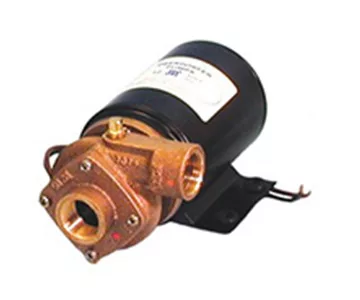Oberdorfer Centrifugal pumps are of the single stage and end suction. Models use open vane style and enclosed style impellers. Centrifugals convert driver energy to kinetic energy in a liquid by accelerating it to the outer rim of a revolving impeller. Since the amount of energy given to the liquid corresponds to the velocity at the impeller vane tip, the faster the impeller revolves (or the bigger the impeller is), the higher the velocity of the liquid at the vane tip and the greater the energy transferred to the liquid. In comparison to positive displacement devices, centrifugals are quieter and require no relief valve to protect the pumps from pressure build-up.
These pumps contain few moving parts resulting in less wear and less maintenance. Our centrifugal family models are constructed out of bronze, which is ideal in marine applications and for handling harsh solvents. Our centrifugal pumps provide up to 20 feet of suction lift and can handle most difficult solvents with the proper fluoroelastomer or Polytetrafluoroethylene (PTFE) seal. Several of our centrifugal models are self-priming.
Low Flow (34 LPM – 94.64 LPM)
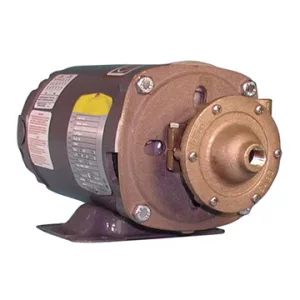
Centrifugal Pump – 101M
These pump housings and mounting brackets are made from cast aluminum or bronze alloy. The rotor is made from stainless steel with a hard chrome plate for improved wear properties. The stator is made from molded Nitrile. The mechanical seal is a carbon and ceramic mechanical rotary face type for positive sealing.
The turning of the helical shaped rotor within the stationary stator creates a progressing cavity similar to a moving piston. Liquid is thus displaced generating a pumping action. Unlike piston pumping, extremely high pressure cannot be created because the stator is made of Nitrile and is flexible. Because of this flexibility contaminated liquids can be handled. High starting torque motors are recommended in order to overcome the high starting friction of the stator. The pump is relatively quiet.
Features
- All Bronze or Corrosion Resistant Aluminum Construction
- Easily Mounted in Field to Your Own 56 Frame
- Motor & 56C For Explosion-Proof Motors
- Carbon Face Mechanical Seal
- Quiet Running
- Can Handle Contaminated Liquids
- Nitrile Stator and Stainless Steel Rotor
Performance
- Max Flow: 9 GPM – 34.07 LPM
- Max Pressure: 12 PSI – 0.828 bar
LIQUIDS & TEMPERATURES
The corrosion resistant alloys used are compatible with common liquids including water, water solutions, oils and many commercial chemicals. Severe solvents are not compatible with the Nitrile and should not be pumped.
SUCTION LIFT
These centrifugal pumps are not self-priming. They must be installed below the liquid level so that the liquid flows to the pump by gravity (flooded suction). However, if a foot valve is used at the beginning of the suction line, and all air is bled from the pump by manual priming, the pump will lift on the suction side up to 15 feet. Such a system relies entirely on the non-leaking foot valve for starting capability.
ROTATION
This helical rotor design demands a single rotation – clockwise when facing the pump drive shaft. Pump rotation and “in” and “out” ports are indicated on the dimension diagrams.
ELECTRIC MOTOR MOUNTING
This pump is supplied close coupled to electric motor or as a pump alone complete with attaching parts and instructions for mounting. Any 56 frame electric motor (or 56C frame) with 5/8 inch shaft diameter, 1725 R.P.M. and of horsepower rating as listed can be used. The motor can be rigid or resilient mounted, sleeve or ball bearings, 50oC rise, capacitor start, counter-clockwise, rotation from shaft end.
(For Gas Engine version, see models 111-UGY/111B-UGY)
(FOR PERFORMANCE AT REDUCED MOTOR SPEEDS, SEE MODEL 121/121B)

Centrifugal Pump – 104M
This close-coupled pump uses a standard NEMA C-Flange Jet Pump Motor with weld-on base and threaded shaft end to accept the pump impeller. Single phase motors are non-reversible and are wired for the proper pump rotation which is counter-clockwise looking at inlet end of pump. See the dimensional drawing. Three phase motors must be checked out for proper rotation when pump is installed. Interchanging of any 2 wires in a 3-phase system will reverse motor rotation.
The pump uses a mechanical type shaft seal with a Nitrile rubber element. It is limited to 212o F. Fluoroelastomer seals and polytetrafluoroethylene (PTFE) seals are available for severe solvents, difficult chemicals, and elevated temperatures.
Features
- Rugged bronze construction
- A standard in the marine air conditioning industry
- Extremely quiet operation
- O-ring housing seal eliminates gasket problems
- Polytetrafluoroethylene (PTFE) barrier seal to protect motor bearings
- Handles contaminated liquids
- Discharge port orientation flexibility – 8 positions
- Mechanical seal – carbon/ceramic, Nitrile – standard, Fluoroelastomer (S10) optional Polytetrafluoroethylene (PTFE) (S11)
- Pump heads mount to standard footed NEMA 56J jet pump motors
- Shafts: 416 Stainless, Nickel Alloy or 316 Passivated Stainless
- Multiple motor options available
Performance
- Max Flow: 24 GPM – 90.85 LPM
- Max Pressure: 22.5 PSI – 1.55 bar
DRIVE
This close-coupled pump uses a standard NEMA C-Flange Jet Pump Motor with weld-on base and threaded shaft end to accept the pump impeller. Multiple motor options are available.
LIQUIDS & TEMPERATURES
The special pump alloys used provide corrosion resistance to many liquids including water, water solutions, and a wide range of commercial chemicals. Questions as to the chemical compatibility of special liquids should be referred to the factory.
Viscous liquids with a maximum viscosity of 2000 Saybolt Seconds Universal can be pumped. However, when pumping viscous liquids as compared with water, a reduction in flow and pressure occurs and the required horsepower rate increases. Liquids heavier than water require additional horsepower in direct proportion to the increase in specific gravity. Liquids contaminated with small solids or abrasives can be handled, but a reduction in mechanical seal life must be expected.
SUCTION LIFT
These centrifugal pumps are not self-priming. They must be installed below the liquid level so that the liquid flows to the pump by gravity (flooded suction). However, if a foot valve is used at the beginning of the suction line, and all air is bled from the pump by manual priming, the pump will lift on the suction side up to 15 feet.
Such a system relies entirely on the non-leaking foot valve for starting capability. The flow of a centrifugal pump can be conveniently controlled by a throttling valve in the discharge line without the need for a relief valve. In centrifugal pumps, the horsepower demand will decrease as the pressure increases. Maximum horsepower occurs with a wide open discharge.
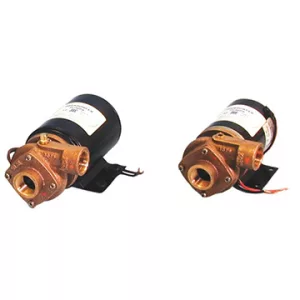
Centrifugal Pump – 170M
These Oberdorfer™ centrifugal pumps have a single open vane rotating impeller. Liquid enters at the center and is thrown outward radically by centrifugal force. The impeller is not in contact with other pump parts resulting in quiet, efficient pumping action. The flow produced is not positive which permits the discharge line to be shut off completely without danger of overloading motors or bursting lines. Consequently, a relief valve is not required.
The flow of these pumps can be conveniently controlled by a throttling valve in the discharge line. Horsepower demand will decrease as the pressure increases. Maximum horsepower occurs with a wide open discharge.
The lip seal is Nitrile with stainless steel spring reinforcement on a stainless steel motor shaft. The seal is friction press fit in a machined housing counter bore. Excessive system pressures above 15 PSI are not recommended as the seal could be forced out of the pump housing.
Features
- Rugged Corrosion Resistant Bronze Construction
- Compact & Light
- Nitrile Lip Seal STD; Optional fluoroelastomer Lip
- TEFC Motors With Corrosion Resistant Passivated 316 SS Shafts
- 1/10 HP Permanent Magnet 12V, 24V, 32V DC Motors
- Rubber Base Grommets For Vibration Dampening
- Insulated Leads
- 1/13 HP Permanent Magnet 12V DC Motor (A95)
Ideal for:
- Marine Air Conditioning
- Engine Block Temperature Control
- Radiator & Heat Exchanger Circulation
- Baitwell Circulation
Performance
- Max Flow: 13 GPM – 49.21 LPM
- Max Pressure: 7 PSI – 0.48 bar
DRIVE
One of the outstanding features of this pump and motor unit is its compact D.C. motor size. Although small, adequate motor power is available. Motors are available in 12, 24 and 32 VDC.
LIQUIDS & TEMPERATURES
This pump is more than capable of pumping water, water solutions, and a wide range of commercial chemicals. Viscous liquids with a maximum viscosity of 2000 Saybolt Seconds Universal can be pumped. However, when pumping viscous liquids (as compared with water) a reduction in flow and pressure occurs and the required horsepower increases. Liquids heavier than water require additional horsepower in direct proportion to the increase in specific gravity. Questions about the chemical compatibility of special liquids should be referred to the factory.
SUCTION LIFT
These pumps are not self priming. They must be installed below the liquid level so that the liquid flows to the pump by gravity (flooded suction). However, if a foot valve is used at the beginning of the suction line, and all air is bled from the pump by manual priming, the pump will lift on the suction side up to 15 feet. Such a system relies entirely on the non-leaking foot valve for starting capability.
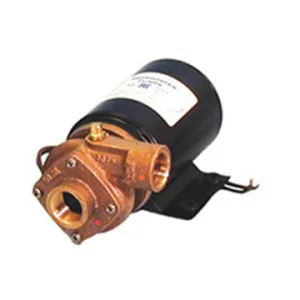
Centrifugal Pump – 172B
These Oberdorfer™ centrifugal pumps have a single open vane rotating impeller. Liquid enters at the center and is thrown outward radically by centrifugal force. The impeller is not in contact with other pump parts resulting in quiet, efficient pumping action. The flow produced is not positive which permits the discharge line to be shut off completely without danger of overloading motors or bursting lines. Consequently, a relief valve is not required.
The flow of these pumps can be conveniently controlled by a throttling valve in the discharge line. Horsepower demand will decrease as the pressure increases. Maximum horsepower occurs with a wide open discharge.
Features
- Rugged corrosion resistant bronze construction
- Compact and light
- Mechanical Seals – Type 6A
- Nitrile Standard
- Fluoroelastomer Options
- TEFC Motors with corrosion resistant passivated 316 SS Shafts
- 1/10 HP permanent Magnet 12V, 24V, 32V DC Motors
- Insulated leads
- Rubber base grommets for vibration dampening
- 1/13 HP Permanent Magnet 12V DC Motor
- 172L threaded shaft style
- 1/8 HP Capacitor Start 50/60 HZ, 115V & 220V AC Motors
- Ignition protection
- Thermal overload protection
- Power cord with plug
Ideal for:
- Marine Air Conditioning
- Engine Block Temperature Control
- Radiator & Heat Exchanger Circulation
- Baitwell Circulation
Performance
- Max Flow: 13 GPM – 49.21 LPM
- Max Pressure: 7.2 PSI – 0.5 bar
DRIVE
One of the outstanding features of this pump and motor unit is its compact size. Although small, adequate motor power is available. A.C and D.C. motors are available.
LIQUIDS & TEMPERATURES
This pump is more than capable of pumping water, water solutions, and a wide range of commercial chemicals.
Viscous liquids with a maximum viscosity of 2000 Saybolt Seconds Universal can be pumped. However, when pumping viscous liquids (as compared with water) a reduction in flow and pressure occurs and the required horsepower increases. Liquids heavier than water require additional horsepower in direct proportion to the increase in specific gravity. Questions about the chemical compatibility of special liquids should be referred to the factory. The pump uses a mechanical type shaft seal with a Nitrile rubber element. It is suitable for water, oils, and some mild solvents and is limited to 212o F, fluoroelastomer is available for up to 400o F.
SUCTION LIFT
These pumps are not self-priming. They must be installed below the liquid level so that the liquid flows to the pump by gravity (flooded suction). However, if a foot valve is used in the beginning of the suction line, and all air is bled from the pump by manual priming, the pump will lift on the suction side up to 15 feet. Such a system relies entirely on the non-leaking foot valve for starting capability.

Centrifugal Pump – 500
This close coupled centrifugal pump uses a mechanical type shaft seal with a Nitrile rubber element. It is suitable for water, oils, and some mild solvents. It is limited to 212o F. fluoroelastomer seals and polytetrafluoroethylene (PTFE) seals are available for severe solvents, difficult chemicals, and elevated temperatures. The impeller is attached directly to the motor shaft. This pump can handle small impurities in the liquid. The flow of a centrifugal pump can be conveniently controlled by a throttling valve in the discharge line without the need for a relief valve. In centrifugal pumps, the horsepower demand will decrease as the pressure increases. Maximum horsepower occurs with a wide open discharge.
Features
- All Bronze Pump Castings
- Stainless Steel Motor Shaft
- Mechanical Seal- Nitrile
- Extremely Quiet
- Will handle difficult solvents with proper seals – Fluoroelastomer (S10) or Polytetrafluoroethylene (PTFE) (S11)
- Long Life
- Does Not Require Relief Valves
- Will Handle Contaminated Liquids
Performance
- Max Flow: 9 GPM – 34.07 LPM
- Max Pressure: 12 PSI – 0.83 bar
DRIVE
This close coupled pump uses a standard NEMA C Flange Jet Pump Motor with weld-on base and threaded shaft end to accept the pump impeller. Single phase motors are non-reversible and are wired for the proper pump rotation which is counter-clockwise looking at the inlet end of the pump. Three phase motors must be checked out for proper rotation when pump is installed. Interchanging of any 2 wires in a 3-phase system will reverse motor rotation.
LIQUIDS & TEMPERATURES
The special pump alloys used provide corrosion resistance to many liquids including water, water solutions, and a wide range of commercial chemicals. Questions as to the chemical compatibility of special liquids should be referred to the factory.
Viscous liquids with a maximum viscosity of 2000 Saybolt Seconds Universal can be pumped. However, when pumping viscous liquids as compared with water, a reduction inflow and pressure occurs and the required horsepower rate increases.
Liquids heavier than water require additional horsepower in direct proportion to the increase in specific gravity.
Liquids contaminated with small solids or abrasives can be handled, but a reduction in mechanical seal life must be expected.
SUCTION LIFT
These centrifugal pumps are not self-priming. They must be installed below the liquid level so that the liquid flows to the pump by gravity (flooded suction). However, if a foot valve is used at the beginning of the suction line and all air is bled from the pump by manual priming, the pump will lift on the suction side up to 15 feet. Such a system relies entirely on a non-leaking foot valve for starting capability.
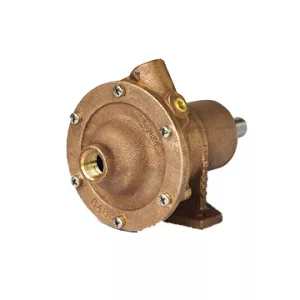
Centrifugal Pump – 50P
Oberdorfer™ centrifugal pumps have a single rotating metal impeller. Liquid enters at the center and is thrown outward radically by centrifugal force. The impeller is not in contact with other pump parts resulting in quiet, efficient, pumping action. The flow produced is not positive which permits the discharge line to be shut off completely without danger of overloading motors or bursting lines. Consequently a relief valve is not required. The liquid flow is proportional to the pump speed-the higher the speed the greater the flow. Horsepower required varies directly as flow and pressure. Maximum horsepower is required with a wide-open discharge line. This is the point of maximum flow. With a throttled discharge, the flow decreases at a greater rate than the pressure increases thereby requiring less horsepower at the higher pressures. This is known as an “unloading” feature of the pump. The 50P centrifugal pump has an external ball bearing isolated from the liquid being pumped. The ball bearing is greased and sealed for life, requiring no maintenance.
Features
- All Bronze Construction
- Heavy Duty Ball Bearings
- Designed for Pulley Drive
- Mechanical Seal
- Quiet Operation
- Handles Contaminated Liquids
- No Lubrication Required
Performance
- Max Flow: 9 GPM – 34.07 LPM
- Max Pressure: 15 PSI – 1.04 bar
DRIVE
The pedestal centrifugal pumps can be direct driven by electric motors at either 3450 R.P.M. or 1725 R.P.M. Performance for both speeds are shown in the curves above. The 50P pedestal centrifugal pump can be pulley driven at any desired intermediate speed.
LIQUIDS & TEMPERATURES
Because centrifugal pumps are more efficient at higher shaft speeds, pumping of viscous or thick liquids is difficult. It is possible to lose as much as 40% pump performance when attempting to pump liquids of viscosity equal to S.A.E. 30 oil at room temperature. SAE 30 oil at room temperature has a viscosity of 2000 Saybolt Seconds Universal. More viscous liquids are not recommended for centrifugal pumps. Heavy liquids can be pumped; however, they demand more horsepower in direct ratio to the weight of water. For example, carbon tetrachloride has a specific gravity of 1.6 which means it is 1.6 times heavier than water and the horsepower required is 1.6 times water horsepower.
SUCTION LIFT
This centrifugal pump is not self-priming. Normally these pumps must be installed below the liquid level so that the liquid flows to the pump by gravity. However, if a foot valve is used at the beginning of the suction line and all air is bled from the suction line and pump by careful manual priming, these pumps will lift liquid on the suction side up to 15 ft. Such a system is only as positive as the ability of the foot valve to seal and keep the suction line and pump full of liquid. If the foot valve should leak, the pump will not prime.
SHAFT SEAL OPTIONS
Mechanical Shaft Seals have Nitrile rubber components (212°F max) as standard. For temperatures up to 400°F a fluoroelastomer seal must be selected by adding code S10 to the pump number. In most instances, fluoroelastomer seals are not field interchangeable with the standard Nitrile seals. Call factory for details.
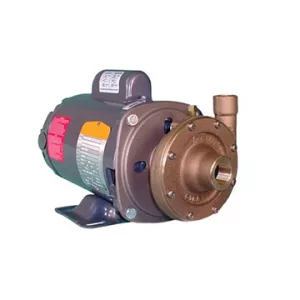
Centrifugal Pump – 600
This close coupled centrifugal pump uses a mechanical type shaft seal with a Nitrile rubber element. It is suitable for water, oils, and some mild solvents. It is limited to 212o F. fluoroelastomer seals and polytetrafluoroethylene (PTFE) seals are available for severe solvents, difficult chemicals, and elevated temperatures. The impeller is attached directly to the motor shaft. This pump can handle small impurities in the liquid. The flow of a centrifugal pump can be conveniently controlled by a throttling valve in the discharge line without the need for a relief valve. In centrifugal pumps, the horsepower demand will decrease as the pressure increases. Maximum horsepower occurs with a wide open discharge.
Features
- Rugged bronze construction
- A standard in the marine air conditioning industry
- Extremely quiet operation
- O-ring housing seal eliminates gasket problems
- Wide hydraulic range
- Handles contaminated liquids
- Discharge port orientation flexibility – 8 positions
- Mechanical seal – carbon/ceramic- Nitlrile – standard, Fluoroelastomer (S10) optional or Polytetrafluoroethylene (PTFE) (S11) optional
- Pump heads mount to standard footed NEMA 56J jet pump motors
- Shafts: 416 Stainless
- Multiple motor options available
- For marine version – see Model 104M
- For pedestal style version, see Model 60P
Performance
- Max Flow: 24 GPM – 90.85 LPM
- Max Pressure: 22.5 PSI – 1.55 bar
DRIVE
This close coupled pump uses a standard NEMA C-Flange Jet Pump Motor with weld-on base and threaded shaft end to accept the pump impeller. Single phase motors are non-reversible and are wired for the proper pump rotation which is counter-clockwise looking at the inlet end of the pump. Three phase motors must be checked out for proper rotation when pump is installed. Interchanging of any 2 wires in a 3-phase system will reverse motor rotation.
LIQUIDS & TEMPERATURES
The special pump alloys used provide corrosion resistance to many liquids including water, water solutions, and a wide range of commercial chemicals. Questions as to the chemical compatibility of special liquids should be referred to the factory.
Viscous liquids with a maximum viscosity of 2000 Saybolt Seconds Universal can be pumped. However, when pumping viscous liquids as compared with water, a reduction inflow and pressure occurs and the required horsepower rate increases.
Liquids heavier than water require additional horsepower in direct proportion to the increase in specific gravity. Liquids contaminated with small solids or abrasives can be handled, but a reduction in mechanical seal life must be expected.
SUCTION LIFT
These centrifugal pumps are not self-priming. They must be installed below the liquid level so that the liquid flows to the pump by gravity (flooded suction). However, if a foot valve is used at the beginning of the suction line and all air is bled from the pump by manual priming, the pump will lift on the suction side up to 15 feet. Such a system relies entirely on a non-leaking foot valve for starting capability.

Centrifugal Pump – 60P
Oberdorfer™ centrifugal pumps have a single rotating metal impeller. Liquid enters at the center and is thrown outward radically by centrifugal force. The impeller is not in contact with other pump parts resulting in quiet, efficient, pumping action. The flow produced is not positive which permits the discharge line to be shut off completely without danger of overloading motors or bursting lines. Consequently a relief valve is not required.
The liquid flow is proportional to the pump speed-the higher the speed the greater the flow. Horsepower required varies directly as flow and pressure. Maximum horsepower is required with a wide open discharge line. This is the point of maximum flow. With a throttled discharge, the flow decreases at a greater rate than the pressure increases thereby requiring less horsepower at the higher pressures. This is known as an “unloading” feature of the pump. Silent, efficient, centrifugal pumping is ideal for convenient equipment location in offices, laboratories, public areas, and living quarters. Long trouble-free service life has made centrifugal pumps acceptable for industrial uses or wherever clean or contaminated liquid compatible with bronze is to be transferred or handled.
The 60P centrifugal pump has an external ball bearing isolated from the liquid being pumped. The ball bearing is greased and sealed for life, requiring no maintenance.
Because centrifugal pumps are more efficient at higher shaft speeds, pumping of viscous or thick liquids is difficult. It is possible to lose as much as 40% pump performance when attempting to pump liquids of viscosity equal to S.A.E. 30 oil at room temperature.
S.A.E. 30 oil at room temperature has a viscosity of 2000 Saybolt Seconds Universal. More viscous liquids are not recommended for centrifugal pumps.
Heavy liquids can be pumped; however, they demand more horsepower in direct ratio to the weight of water. For example, carbon tetrachloride has a specific gravity of 1.6 which means it is 1.6 times heavier than water and the horsepower required is 1.6 times water horsepower.
Features
- Rugged Bronze Construction
- Quiet Operation
- O-Ring Housing seal eliminates gasket problems
- Mechanical Seal – Carbon/Ceramic, Nitrile – standard, Fluoroelastomer (S10) or Polytetrafluoroethylene (PTFE) (S11) – options
- Designed for Pulley Drive
- Heavy Duty Integral Steel Shaft and Ball Bearings
- Handles Contaminated Liquids
- No bearing lubrication required
- For Close Coupled Style, see Model 600
Performance
- Max Flow: 25 GPM – 94.64 LPM
- Max Pressure: 29 PSI – 2 bar
DRIVE
The pedestal centrifugal pumps can be direct driven by electric motors at either 3450 R.P.M. or 1725 R.P.M. Performance for both speeds are shown in the curves above. The 60P pedestal centrifugal pump can be pulley driven at any desired intermediate speed.
LIQUIDS & TEMPERATURES
Bronze pumps are suitable for most common liquids in the PH-range from 4 to 11.
The temperature limit for bronze pumps is 212°F, higher temperatures are possible with Fluoroelastomer or Chemlon seals. If in doubt, consult with factory.
SUCTION LIFT
This centrifugal pump is not self priming. Normally these pumps must be installed below the liquid level so that the liquid flows to the pump by gravity. However, if a foot valve is used at the beginning of the suction line and all air is bled from the suction line and pump by careful manual priming, these pumps will lift liquid on the suction side up to 15 feet. Such a system is only as positive as the ability of the foot valve to seal and keep the suction line and pump full of liquid. If the foot valve should leak, the pump will not prime.
SHAFT SEAL OPTIONS
Mechanical Shaft Seals have Nitrile rubber components (212°F max) as standard. For temperatures up to 400°F a Fluoroelastomer seal must be selected by adding code S10 to the pump number. To handle strong solvents and chemicals (compatible with bronze), a Chemlon seal (500°F max) must be specified by adding code S11 to the pump number. In most instances, Fluoroelastomer and Chemlon seals are not field interchangeable with the standard Nitrile seals. Call factory for details.
What is a Centrifugal Pump?
Introduction
A centrifugal pump is a rotodynamic pump that uses a rotating impeller to increase the pressure and flow rate of a fluid. Centrifugal pumps are the most common type of pump used to move liquids through a piping system. The fluid enters the pump impeller along or near to the rotating axis and is accelerated by the impeller, flowing radially outward or axially into a diffuser or volute chamber, from where it exits into the downstream piping system.
Centrifugal pumps are most often associated with the radial flow type. However, the term “centrifugal pump” can be used to describe all impeller type rotodynamic pumps including the radial, axial and mixed flow variations.
Design
Oberdorfer Centrifugal pumps are of the single stage and end suction. Models use open vane style and enclosed style impellers. Centrifugals convert driver energy to kinetic energy in a liquid by accelerating it to the outer rim of a revolving impeller. Since the amount of energy given to the liquid corresponds to the velocity at the impeller’s vane tip, the faster the impeller revolves (or the bigger the impeller is), the higher the velocity of the liquid at the vane tip and the greater the energy imparted to the liquid. In comparison to positive displacement devices, centrifugals are quieter and require no relief valve to protect the pumps from pressure build-up.
Application Range
Centrifugals are well suited for thin fluids and normally run at 3450 RPM speed. Because these units have large internal clearances, they can handle small impurities in the fluid. Bronze centrifugals can pump a variety of common fluids in the PH range from 4-11 and are particularly well suited for non-potable water or sea water service. The temperature limit for units equipped with buna seals is 212oF. Solvent handling and higher temperatures are possible with viton or teflon seals. Centrifugals are not well suited for viscous fluids; becoming less efficient with increased viscosities. The product portfolio of over 28 models spans a hydraulic coverage range from 2.2 GPM to 100 GPM with pressures to 58 psi (135 feet).
Pump Driver Mounting
Close Coupled Pump Heads – pump adapters provide the required alignment to C-faced motors.
Impeller Shimming – Since jet pump motor shaft projections can vary, pump heads are provided with impeller shim kits. In general, an air gap of 0.010” to 0.015” is recommended between the rear shroud of the impeller and the motor adapter face. Once the pump casing is mounted, check to be sure that the impeller is not rubbing against the casing. Adjust shimming as needed.
Pedestal Pumps – Some base mount kits designed for use with Oberdorfer Bronze Gear Pumps, may also be adaptable for use with Oberdorfer Pedestal Centrifugal pumps. These kits include baseplate, coupling components, coupling guard, and hardware.
Construction
Housings: Oberdorfer Pumps metal pump housings are made of top quality rugged cast bronze or light weight corrosion resistant cast aluminum. Shafts are corrosion resistant stainless steel or Monel.
Bearings: Pedestal Pumps use heavy duty “lubricated for life” ball bearings suitable for pulley loads. Most of the Close Coupled pumps are designed to fit jet pump C-faced motors; relying on the motor bearings to support pump loads.
Seals: Conventional mechanical shaft seals with carbon and ceramic faces are used. A variety of elastomers and seal styles are available. Model 170M uses a lip seal instead. Static housing sealing is accomplished with elastomeric O-ring seals or cellulose gaskets.

